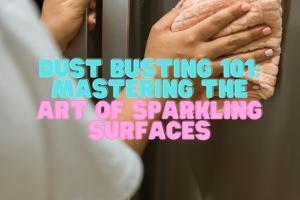Mastering Dusting: A Comprehensive Guide for a Dust-Free Home

-
Quick Links:
- 1. Introduction
- 2. Understanding Dust
- 3. Tools and Materials for Dusting
- 4. Step-by-Step Dusting Guide
- 5. Effective Dusting Techniques
- 6. Dusting Different Areas of Your Home
- 7. Case Studies: Success Stories
- 8. Common Mistakes to Avoid
- 9. Expert Insights on Dusting
- 10. FAQs
1. Introduction
Dusting is often seen as a mundane chore, but it plays a crucial role in maintaining a clean and healthy living environment. Dust accumulation can lead to allergies, respiratory issues, and an overall decline in indoor air quality. This guide will provide you with comprehensive insights on how to effectively dust your entire house, ensuring each surface is left immaculate.2. Understanding Dust
Dust is a mixture of particles from various sources, including skin cells, dirt, pollen, and fabric fibers. Understanding what constitutes dust helps us appreciate its potential impact on our living spaces: - **Composition**: Dust is composed of organic and inorganic materials. The presence of allergens such as pet dander and mold can trigger respiratory problems. - **Health Implications**: Prolonged exposure to dust can lead to health issues, particularly in vulnerable populations such as children and the elderly.3. Tools and Materials for Dusting
To dust effectively, you'll need the right tools. Here’s a list of essential items: - **Microfiber Cloths**: Ideal for trapping dust without spreading it around. - **Dusting Wands**: These are especially useful for high places and hard-to-reach areas. - **Vacuum Cleaner with a HEPA Filter**: Helps in removing dust from carpets and upholstery. - **Duster with Extendable Handle**: For ceilings and tall furniture. - **Cleaning Solution**: A non-toxic cleaner can help in removing sticky dust.4. Step-by-Step Dusting Guide
Follow these steps to ensure a thorough dusting: 1. **Preparation**: Gather all your tools and materials. 2. **Declutter**: Remove items from surfaces to make dusting easier. 3. **Start from the Top**: Dust ceiling fans and light fixtures first, then move downwards. 4. **Dust High Surfaces**: Use an extendable duster for shelves and cabinets. 5. **Wipe Down Surfaces**: Use a microfiber cloth to wipe surfaces, always moving from top to bottom. 6. **Don’t Forget the Floors**: Vacuum carpets and use a dust mop for hard floors.5. Effective Dusting Techniques
Here are some techniques to enhance your dusting efficiency: - **Top to Bottom**: Always dust from the highest point downwards to avoid re-dusting lower surfaces. - **Suction, Not Just Dusting**: Use a vacuum cleaner with a HEPA filter to suck up dust from carpets and upholstery. - **Damp Dusting**: For stubborn dust, slightly dampen your cloth. This prevents dust from becoming airborne.6. Dusting Different Areas of Your Home
Dusting varies significantly from one area to another: - **Living Room**: Pay attention to electronics, furniture, and decorative items. - **Bedroom**: Dust nightstands, dressers, and under the bed. - **Kitchen**: Focus on countertops, cabinets, and appliance surfaces. - **Bathrooms**: Don’t forget to dust light fixtures and shelves.7. Case Studies: Success Stories
In this section, we will explore how effective dusting has transformed living spaces. **Case Study 1: The Johnson Family** After implementing a regular dusting schedule, the Johnson family reported a significant decrease in allergy symptoms, particularly for their children. **Case Study 2: Office Space Revamp** An office that struggled with dust-related complaints saw increased productivity after regular dusting routines were established, leading to a healthier work environment.8. Common Mistakes to Avoid
Avoid these common pitfalls when dusting: 1. **Using the Wrong Tools**: Avoid feather dusters as they often just spread dust around. 2. **Skipping Areas**: Make a checklist to ensure no area is overlooked. 3. **Dusting Without a Plan**: Dusting without a strategy can lead to wasting time and effort.9. Expert Insights on Dusting
According to cleaning experts, the importance of a consistent dusting routine cannot be overstated. Dr. Jane Smith, an allergist, emphasizes that “regular dusting can significantly improve indoor air quality and overall health.”10. FAQs
1. How often should I dust my home?
It is recommended to dust at least once a week to prevent dust buildup.
2. Can dusting reduce allergies?
Yes, regular dusting can help reduce allergens in the home, improving overall health.
3. What is the best tool for dusting?
Microfiber cloths are considered the best as they trap dust effectively without spreading it.
4. Should I dust or vacuum first?
Dust first and then vacuum to ensure that any dust that falls to the floor is picked up.
5. Is it necessary to use cleaning solutions while dusting?
While it’s not necessary, using a cleaning solution can help lift sticky dust and grime.
6. What can I do about dust in hard-to-reach areas?
Use extendable dusters or vacuums with specialized attachments for hard-to-reach areas.
7. Can I dust with a dry cloth?
Yes, but a damp cloth is often more effective for capturing dust particles.
8. How can I reduce dust in my home?
Regular cleaning, using air purifiers, and minimizing clutter can help reduce dust levels.
9. What is the difference between dusting and cleaning?
Dusting refers specifically to removing dust from surfaces, while cleaning encompasses a broader range of tasks.
10. Is it helpful to use a vacuum with a HEPA filter?
Yes, HEPA filters can trap small particles, improving indoor air quality.
Random Reads
- How to light a gas fireplace
- How to light a fire in a fireplace
- Unlocking epona ocarina of time
- Unlocking convenience apple wallet iphone
- How to recover deleted voicemail messages on android
- How to open and play flv files
- How to open arf file
- Mastering word grouping objects
- How to invert colours in ms paint
- How to install windows 10